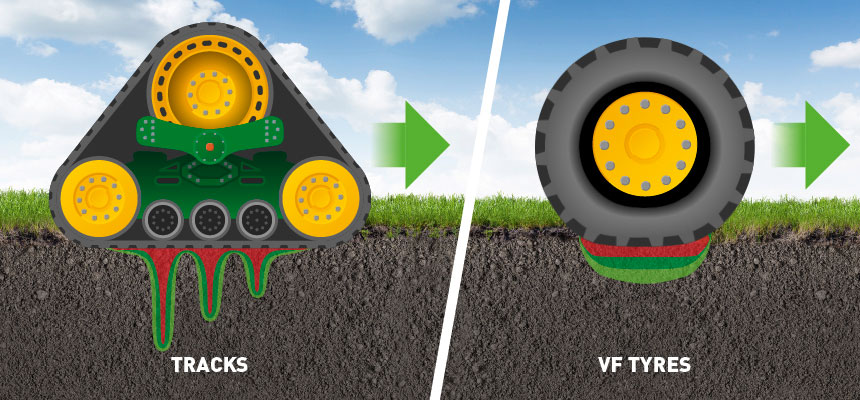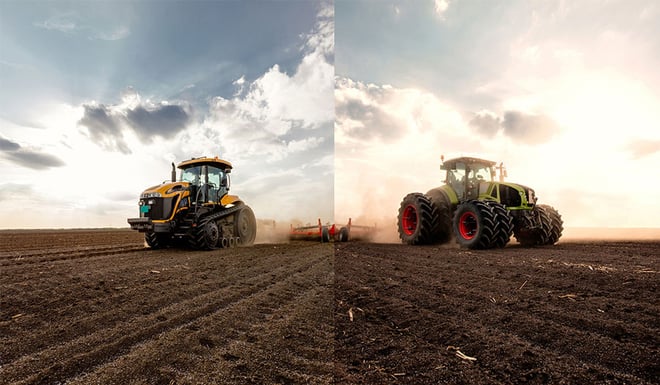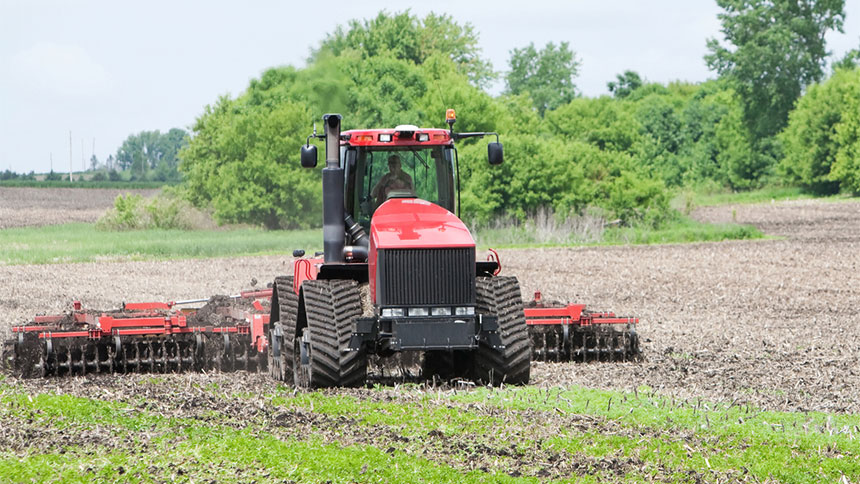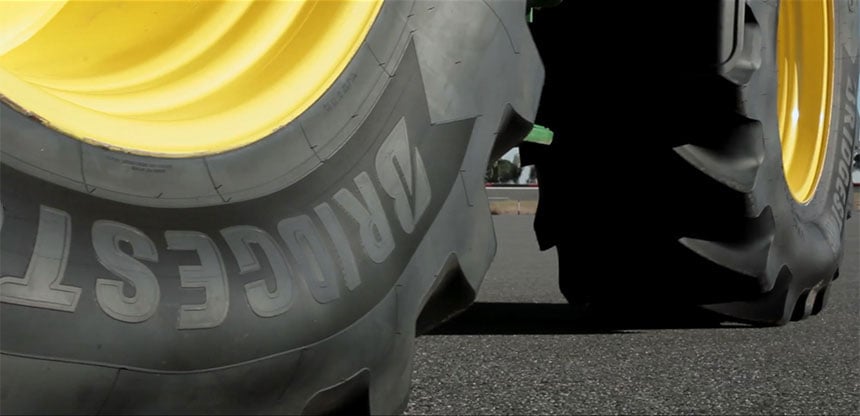There is a rising number of tractors or harvesters that are equipped with tracks, so it is natural to wonder whether it would be wise to opt for this type of equipment which has many benefits if you work with powerful machines and very large implements.
However, technological advancements in the field of tyre manufacturing also make it possible to work with powerful machinery and it’s quite difficult to establish clearly the pros and cons of each of the two solutions.
In this article we take a closer look for you and try to determine in which cases tracks are preferable and in which cases wide VF technology tyres are better:
1. Soil compaction: many misconceptions
The predominant idea when you decide to equip your machines with tracks is soil preservation and the desire to avoid compaction. Yet as it turns out, wide VF tyres are also a good way of avoiding soil compaction. These tyres allow you to work, with a heavy load, at a very low inflation pressure of around 0.8 bar, or even lower, which means that the load is spread over a larger surface area on the ground. And this is where the difference lies, tracks cover a larger surface area on the ground, but unfortunately the weight is not spread evenly over the entire length of the tread. There are peaks in pressure at the level of the rollers and almost no pressure at all on the rest of the surface area. As tracks are generally mounted on heavier machines, the end result will be an increase in soil compaction.
It is very different for a wide, low-pressure VF tyre, because the air within the tyre is at a constant pressure and therefore the entire surface in contact with the ground bears the weight of the machinery in an even and uniform way.
 There are deeper compression areas at the level of the tracks’ rollers
There are deeper compression areas at the level of the tracks’ rollers
than for the tyre which spreads out the pressure evenly
Wide VF technology tyres are the most effective for preserving your land against compaction, above all if you take account of the fact that they are generally used on less heavy vehicles. With precise management of the pressure in your tyres using a remote inflation system for example, you can work at very low pressure and really make a difference in terms of preserving your crops and future yields.
On the other hand, with caterpillar tracks, when manoeuvring or turning corners at the end of the crop line, tractors with two caterpillar tracks are particularly aggressive for the arable layer of soil, as they displace a large quantity of earth due to the scuffing of the caterpillar tracks during tight cornering.
2. Traction capacity: to state the obvious
Tracks have a very large contact patch with the ground and the number of lugs or studs in direct contact with the soil is far greater even than with VF tyres. The tracks’ ability to get a good hold on loose soil is therefore much better, especially for machines equipped with 4 caterpillar tracks. The only tyre solution that could get anywhere near in terms of traction capacity would be using duals on the front and at the rear, which would still not be equivalent to a tracks configuration in terms of traction.
Much less slip with tracks
Used in similar soil and drawn implement conditions, tracks have a very low slip ratio of around 5% whereas tyres have a much higher slip ratio in the range of 10% to 20%, depending on how wet the ground is.
The greater weight of tracks tractors has an impact on the slip ratio and leads to better adherence for this type of tractor. Even with heavier ballasting and a good distribution of the ballast on a tractor equipped with tyres, the slip ratio will be higher.
The tracks’ very low slip ratio is a strong point for traction, of course. Nevertheless, you have to consider that it’s also a weak point for compaction, because the compression linked to the vehicle mass is exerted vertically without any slip, whereas a tyre operating with a higher slip ratio minimises the soil compaction effect.
3. The size of the implements
Saving time and covering a greater surface area in less time is a challenge that we would all like to solve. Using bigger implements is a way of improving productivity per hectare significantly.
As traction capacity is greater on machines equipped with tracks, you increase the ability to pull very wide and very heavy implements, so these machines are more effective in this respect than tractors equipped with tyres.
But beware, tractors equipped with tracks are already much heavier (the tracks tread itself represents a considerable additional weight) than their counterparts with tyres, if you consider the heavy load transfer for a large sized implement, you end up with a load per axle that is often much higher than the ground’s natural bearing capacity.
A higher total weight always generates more compaction. So heavy implements and a heavy tracks tractor will inevitably compact the soil, especially deeper down (60-80cm).
The productivity gains linked to the speed of work may be lost in the long run as a result of the deterioration of the soil linked to compaction caused by trailers that are too heavy. The structural damage caused to the soil linked to compaction leads to a loss of yield of 5% to 30%, whatever the crop. It’s a shame therefore to waste all the effort put in earlier in terms of decompaction, soil preparation, sowing or spraying with low-pressure tyres if you carry out your harvesting campaign with a harvester that is too heavy, even equipped with tracks.
4. The budget
This is certainly the weak point for tracks tractors, which represent a direct additional cost of up to 50,000 euros, for certain combine harvesters, compared to a similar model equipped with tyres.
Fuel consumption is higher overall on the road with tracks, at a lower speed than for a tractor with tyres used at the right inflation pressure.
This difference in fuel consumption may be offset by the savings made in the field as a result of the higher traction capacity.
The fuel budget therefore depends on the layout of your farm and if you have to travel by road a lot, tracks are not the right choice; a set of tyres will cost you much less and be more efficient.
More maintenance costs for tracks
The use of tracks leads to higher costs. The tread deteriorates in the same way as tyres: fissures or damage to the tread, excessive wear to the lugs, cracks in the lugs or broken off lugs, etc. But it is also much more sensitive to debris and requires regular check-ups.
The budget necessary for the replacement of the tread is significant, and increases with the regular replacement of the rollers, adjustment of alignment of the tracks which is indispensable if you wish to avoid wearing them down too rapidly and the level of labour required is higher.
Tracks equipment will increase your average cost of use from 6 to 10 per hectare.
Conclusion :
For heavier implements and the most powerful machines, the 4 caterpillar track configuration is globally the best at the level of performance, even though working with lighter equipment is always preferable for soil preservation. Using wide VF tyres for lighter vehicles will give you better value for money and in the end there will certainly be more benefits to be gained thanks to the versatility of the equipment.
The Bridgestone-agriculture.eu blog is written and administered by tractor tyre experts who are available to provide you with the advice you need on the subject of your agricultural tyres. They allow you to maximise your productivity with information on all subjects linked to tyres: Cheap tractor tyres — Technical data for agricultural tyres — Air pressure advice — Solutions to avoid soil compaction — Sprayer tyre pressure — Why and how to ballast your tractor tyres — When to use dual wheels — The mechanical causes of abnormal wear — Cheap agricultural tyres – etc.
To learn more and boost your farm's profits, Bridgestone-Agriculture is offering you a free, detailed white paper that explains the essential role your agricultural tyres play in your productivity.
Most people who read this article have also read some of the following articles:
- 5 essential techniques to optimise your agricultural tyres
- Equipment sharing cooperatives: How to manage the agricultural tyre budget?
- Duals or low-pressure agricultural tyres: which to choose?
- What is the maximum load that your tractor tyres can carry?
- How do you ensure that your tractor tyres have a good self-cleaning capacity?
- Agricultural tyre evolution, what impact on my farm?
- Agricultural contractors: improving quality of service with an adapted agricultural tyre
- Which vibrations are directly linked to agricultural tyres?
- Load comparison between standard agricultural tyres and VF tyres
- Impact of the loaded radius for my agricultural tyres
This information is intended only to make you aware of the technical and functional aspects of agricultural tires and their use. It does not allow you to make a judgment or a definitive conclusion on a given problem. Only your agricultural tire expert is able to make a technical assessment and take a final decision, case by case.
Leave a
commentary
Your email address will not be published.
Required fields are indicated with *











